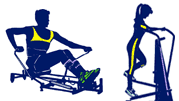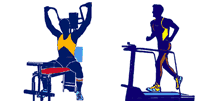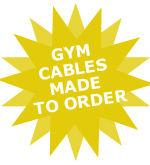


   |
|
|
| |||||||||||||
|
TREADMILL SAFETY DO’S AND DON’TS The first thing to do before using your new treadmill or starting any exercise program is to visit your personal physician and get a complete physical. The next step is to read the owner's manual that came with your treadmill from cover to cover. Most treadmill owner's manuals contain product safety information that is specific to your model as well as electrical outlet specifications, power requirements, safe installation practices and general care instructions as well as how to operate your new treadmill. Most residential treadmills come equipped with a safety lanyard. They may call it a safety tether, safety key, safety magnet, safety cord or some similar term. Most safety cords have a magnet that affixes to the console or a safety key that gets inserted into the treadmill (that enables the walking belt movement) on one end, a cord in the middle and a clip on the other end that the treadmill user should attach to their clothing. If the user falls or canft keep up with the speed of the treadmill, the safety cord is designed to shut off the treadmill and help to avoid or at least to minimize injury. Always use the safety key assembly and when the treadmill is not being used, remove the safety lanyard and store it out of the reach of children, because the running belt will not move without the safety key or safety magnet in place. Keep the area behind your treadmill clear of any obstruction for an area of at least four feet and there should not be a wall within four feet of the back of the unit. The reason for this is that should the user lose control of the treadmill or lose one's balance, it is a strong possibility that he or she will be thrown off the back by the force of the moving running belt. Having a clear open space behind the treadmill provides an opportunity to regain onefs footing while avoiding any possible impact with foreign objects or walls. Unless otherwise directed by your owner's manual, never use a power surge protector strip for a treadmill. They can trip off in response to a heavy footstep and cause the treadmill to shut off suddenly and unexpectedly, resulting in the user propelling themselves forward and crashing into the treadmillfs display console. If it is necessary to use an extension cord for a residential treadmill, be sure that it is a TREADCORD, an extension cord specifically for treadmills. Never walk backwards or sideways on a treadmill. These exercise machines are designed for walking or running in a forward direction only. Any other use is dangerous. Do not stand on the walking belt when starting the treadmill. This puts a strain on the treadmill's drive motor and the motor controller and can shorten their life expectancies. It is a better procedure to straddle the running belt with your feet on the foot rails, start the belt moving at a very low speed, then step onto the running belt while holding onto the handrails. Understand your own limitations Donft try to run on your treadmill at speeds that you can barely handle. Such behavior is likely to cause a person to lose their footing on the moving running belt. Never allow children to use a treadmill unless they are under the supervision of a responsible adult. Treadmills are powerful motorized machines that can help keep us healthy by providing cardiovascular workouts, but they must be treated with respect and used properly. Many of todayfs treadmills contain sophisticated electronics and motor control circuitry. Treat your treadmill like you would treat your computer. If you do not intend to use it for an extended period of time or if lightening is predicted, unplug the treadmill from the outlet. Treadmill safety requires that you keep it operating properly. If it isn't functioning as designed or if you are getting error codes, have your treadmill repaired by a qualified technician. Also, besides the routine maintenance that a homeowner can do, as outlined in the owner's manual, on average a residential treadmill should receive professional preventive maintenance about every two years or so and more often if it is heavily used.
|
  |
|
Ellipticals • Skiers • Rowing Machines • Multi-Station Gyms Single-Station Strength Units • Upper Body Cycles |
PA NJ DE |
T | B | E | R | G | L | 7 | Z | TX | FX | HG | EFB | R | TRN | TRP | TRA | TRW | TRPN | SRP | SRN | SRW | CRP | CRN | CRW | PT | PMT | LFT | LT | ERA